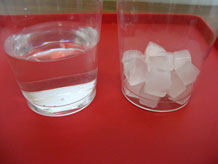How are ice and water the same and different?
2. Explore

Properties of ice and water
Distribute materials. To address the investigation question, students compare and contrast the properties of ice and water and record their observations on the page [Comparing ice and water] in their Science Notebooks.
Prepare for the next investigation
Students collect data in preparation for the next investigation: What happens to the weight and volume of water when it freezes? Show students a plastic bottle 3/4 filled with room temperature water:
- If we keep this water bottle closed, and we don't change it in any way except to freeze it, do you predict its weight will increase, stay the same, or decrease? What makes you think this?
- What do you predict will happen to the volume? What makes you think this?

Give students a few minutes to record their predictions and explain their reasoning on the page [Predictions about freezing water] in their Science Notebooks.
Distribute the remaining materials to each group. Each pair of students will prepare their water bottles for freezing, following the procedure described in their Science Notebooks and here:
- Place a strip of masking tape vertically on the outside of water bottle.
- Mark the water level on the tape. If necessary, adjust the water level to align with the mark, using the pipette.
- Write team members' initials on the tape.
- Weigh the bottle and water and record the data in the table on the page [What happens to weight and volume when water freezes and ice melts?], in their Science Notebooks. For this investigation students will always weigh the water and the water bottle together, so there is no need to determine and subtract tare weight.



